The megaquake off Russia‘s coast may have done more than shake the region, it could trigger volcanic eruptions across the Pacific’s ‘Ring of Fire.’
The Ring of Fire is a 25,000-mile chain of volcanoes and earthquake zones that stretches around the Pacific Ocean, home to about 75 percent of the world’s active volcanoes and frequent earthquakes.
Experts warned the 8.8-magnitude quake released enough energy to disturb underground pressure systems far from the epicenter, potentially destabilizing magma chambers beneath active volcanoes along the arc.
Michael Manga, a geoscientist at the University of California, Berkeley, told DailyMail.com: ‘The volcanoes in volcanic arcs, including Chile, the US Cascades, Japan, Indonesia and Kamchatka, are prone to erupt after earthquakes.’
He noted not all volcanoes will be affected, but those in the westernmost part of the arc are more likely to respond. That puts more than 100 volcanoes across Russia, Japan, the Philippines and Indonesia at increased risk.
‘The volcanoes in Kamchatka are the most likely to possibly respond. Klyuchevskoy erupted just after the earthquake,’ Manga said .
Data from the US Geological Survey (USGS) showed the earthquake struck about 84 miles east-southeast of Kamchatska, Russia at around 7:24pm EST, marking the sixth strongest earthquake ever.
It was also believed to be the strongest to strike on the entire planet in 14 years, when a 9.1 megaquake hit northeast Japan and left 19,747 people either dead or missing.
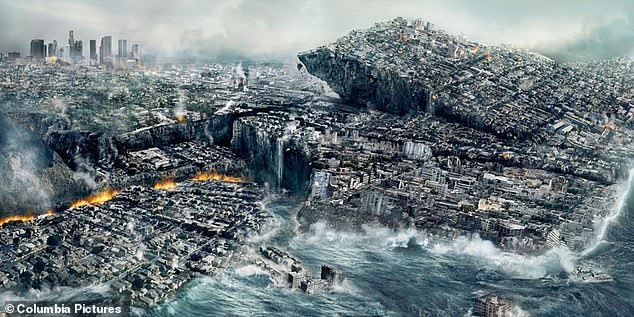
A picture from the movie San Andreas gives an idea of the carnage that could be caused by the Ring of Fire igniting
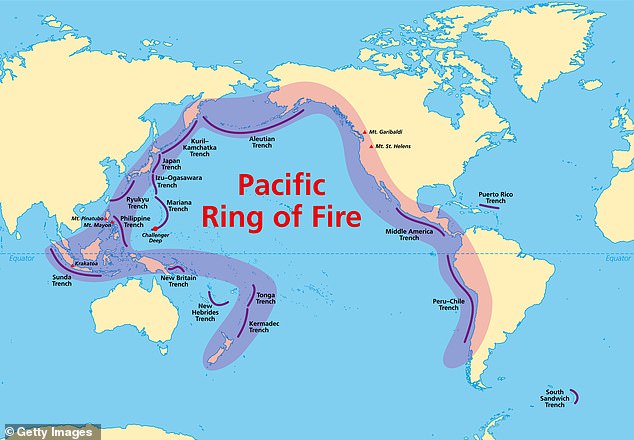
The Ring of Fire, a 25,000-mile arc encircling the Pacific Ocean, is home to 75 percent of the world’s active volcanoes and frequent earthquake
Residents in Hawaii were forced to evacuate from coastal areas as the entire island chain braced for the impact to strike. Water was seen receding at around 1.40am ET.
The first tsunami waves hit Hawaii at 2.20am ET. Water levels were above four feet in Haleiwa on Oahu’s north shore, reaching five feet just minutes later and causing floods.
While millions remain under tsunami advisories, experts are also monitoring volcanoes outside of the epicenter.
While the overall threat is low, Manga said the quake raised eruption chances by five to 12 percent, meaning a volcano with a one percent yearly risk now faces about 1.1 percent.
The elevated threat is predicted to last from two months to two years because the earthquake’s impact on underground pressure and magma movement can take time to trigger an eruption.
Large earthquakes like the one off Russia’s coast can affect volcanoes in several ways, even at great distances.
When tectonic plates suddenly shift, they release massive energy that travels through the Earth’s crust as seismic waves.
These waves can increase stress or pressure within magma chambers or along existing fractures in the crust. In some cases, this added stress can weaken the rock surrounding a magma reservoir or open new pathways for magma to rise.
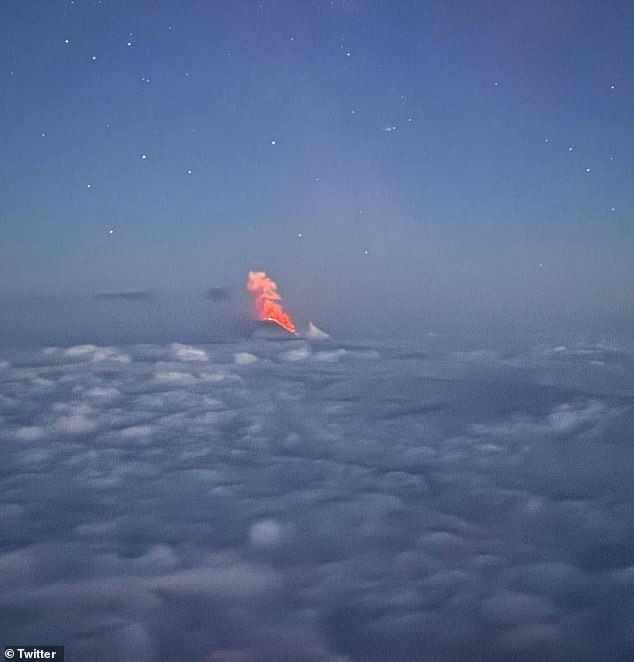
An expert warned that volcanoes along the Ring of Fire would respond to the earthquake. The Klyuchevskoy volcano in Kamchatka erupted on Wednesday after the earthquake in Kamchatka, Russia (pictured)
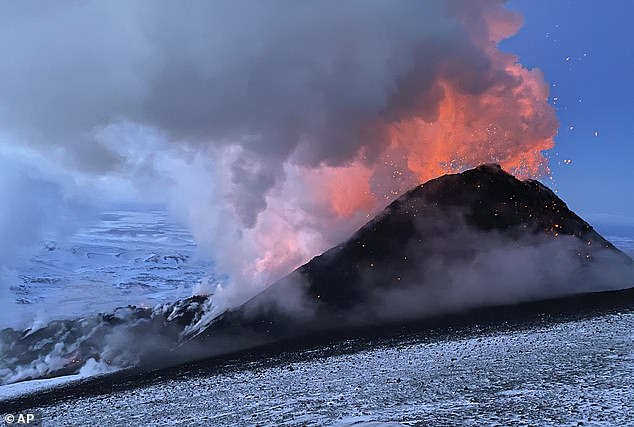
Located around 280 miles north of the regional capital, Petropavlovsk-Kamchatsky, Klyuchevskoy is one of the highest volcanoes in the world. Pictured is an eruption in 2021
Additionally, the shaking can disrupt gas bubbles inside magma, making it more buoyant and unstable, conditions that favor eruption.
Volcanoes that are already active or ‘primed,’ with magma close to the surface, are the most vulnerable to this kind of triggering.
That is what Manga suggested led to the eruption of the Klyuchevskoy volcano in Kamchatka.
‘It may have been active already as temperature anomalies were recorded by satellites in late May, so it could be it that it just became more active,’ he said.
Located approximately 280 miles north of the regional capital, Petropavlovsk-Kamchatsky, Klyuchevskaya Sopka is one of the tallest volcanoes in the world, rising 15,584 feet in Russia’s Kamchatka region.
On Wednesday, observers reported explosive activity and streams of lava descending the volcano’s western slopes.
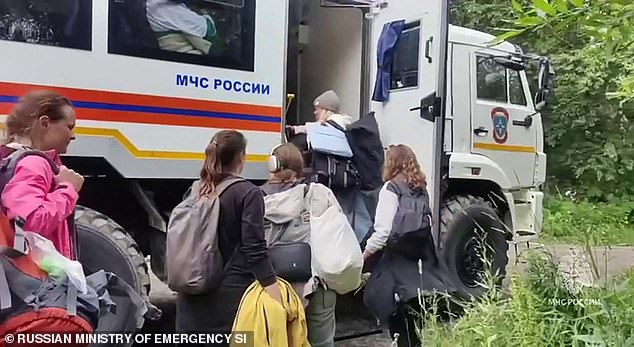
The heightened risk could last from two months to two years, as the quake’s impact on underground pressure and magma movement may take time to spark an eruption. Pictured are people in Russia piling into an emergency vehicle on Wednesday
Scientists had been expecting the eruption, as the volcano’s crater had been filling with lava for several weeks, accompanied by intermittent ash plumes.
Often referred to as the ‘Land of Fire and Ice,’ Kamchatka is one of the most volcanically active regions on Earth, home to roughly 300 volcanoes, 29 of which remain active, according to NASA’s Earth Observatory.
Geographically, the Pacific Ocean’s Ring of Fire stretches from Russia and Japan in the west to the western coast of the US, and down to Antarctica, where it includes Mount Erebus, the southernmost active volcano on Earth.
The region also features deep ocean trenches formed by tectonic subduction zones. Because of this vast, interconnected system, a major eruption or earthquake in one part of the Ring of Fire can trigger alerts and concerns around the world.
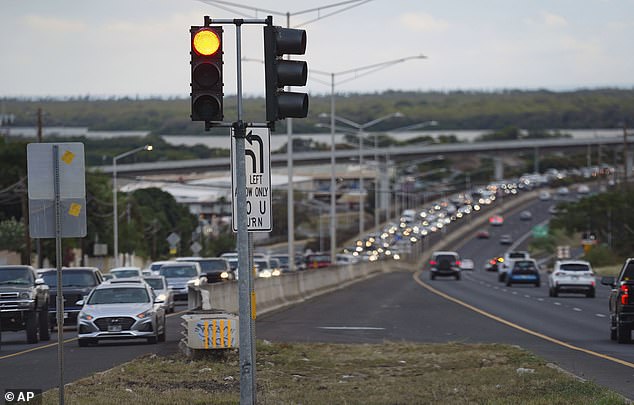
Hawaiian residents evacuated coastal areas as the island chain braced for impact, with water visibly receding – a sign of an incoming tsunami
Manga said that US volcanoes along the arc will not respond to the major earthquake.
However, there are several that have shown increased activity this year, including the Great Sitkin Volcano in Alaska, which is currently under ‘Watch.’
The Alaska Volcano Observatory (AVO) shared an update on Tuesday, saying: ‘Lava continues to erupt in the summit crater of Great Sitkin Volcano.
‘Low-level seismicity continues with occasional small earthquakes and rockfall signals.’
Hawaii’s Kilauea is also under a ‘Watch’ due to its latest eruption ending just 10 days ago.
‘Current hazards include volcanic gas emissions, along with windblown volcanic glass (Pele’s hair) and tephra deposited during earlier eruptive episodes,’ the USGS shared in a statement.
